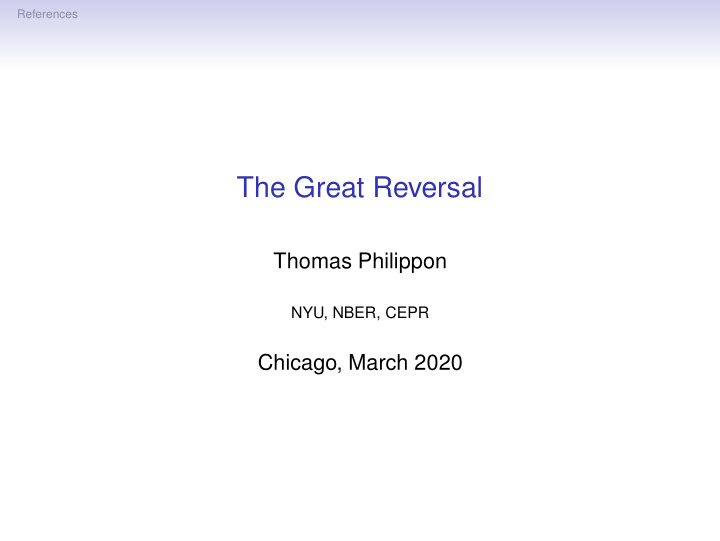



References The Great Reversal Thomas Philippon NYU, NBER, CEPR Chicago, March 2020
References Cost of Internet Access, 2018 Rank Country Broadband Cost 40 France $ 31 43 South Korea $ 32 53 Germany $ 37 ... 119 US $ 68
References Concentration and Markup: Telecom Panel A: Telecom .3 .5 .2 .4 .3 .1 Mark−up CR8 .2 0 .1 −.1 0 −.2 1990 2000 2010 year Mark−up CR8
References US: After-Tax Net Profit Margins Panel B. Profits/VA .12 .1 .08 .06 .04 1970q1 1980q1 1990q1 2000q1 2010q1 2020q1 Source: FRED Non Financial Corporates.
References The Rise in US Concentration Panel A. Cumulative Change in CR8 (%) 8 6 4 2 0 1980 1990 2000 2010 Manufacturing Non−Manufacturing Source: U.S. Economic Census for all Businesses. Dashed lines because of changes in industry classification from SIC to NAICS.
References Two Big Questions • Good vs. Bad Concentration? - Good concentration: low prices and productivity growth • e.g, retail & wholesale trade • returns to scale; intangible investment - Bad concentration: high prices and low productivity • e.g., telecoms, airlines, healthcare • what are these barriers? • Technology vs. Policy? - Network effects vs regulation & antitrust
References Walmart .08 .6 .07 .4 Market Share Profit Margin .06 .2 .05 .04 0 1970 1980 1990 2000 2010 2020 year Profit Margin Market Share
References Good Concentration / Bad Concentration Average scores for PC1 and PC2 .6 .4 .2 0 −.2 −.4 1995 2000 2005 2010 2015 year PC1: "Intangibles" PC2: "Barriers to Entry"
References Technology or Policy What about Europe?
References PMR Reforms in EU 1.5 1 Average # of Reforms .5 0 −.5 1970 1975 1980 1985 1990 1995 2000 2005 2010 2015 Source: Duval et al. (2018).
References Comparison of Telecom Prices in FR vs US Relative Price of Communication in France 1.2 1.1 Relative price 1 .9 .8 .7 2004 2006 2008 2010 2012 2014 year
References Regulation: US vs EU POL 3 GRC 2.5 GRC POL GRC POL 2 GRC POL 1.5 1 1995 2000 2005 2010 2015 Year EU US Source: OECD PMR.
References Markups EU vs US
References The MissingTrillion Dollar • Monthly savings per households: $300 • Nationwide annual household direct savings: $600 billion • General equilibrium impact of returning to competitive markets - GDP: $1 trillion - Labor Income: $1.25 trillion - Profits: -$250 billion
References What Happened? • European paradox: What changed in the late 1990s? - Single market –> political economy, competition policy - Strong & independent regulators • American paradox: What changed in the 2000s? - More corporate lobbying, less antitrust - Barriers to entry • Excessive regulations &licensing • Predatory behavior (tech, health)
References Lobbying Expenditures 3.5 Total Lobbying Expenditures ($ BN USD) 3 2.5 2 1.5 1 2000 2005 2010 2015 Year US − Total US − Business EU − Total EU − Business
References Conclusion The End
References EU Paradox 8 6 4 2 0 Dominance Restrictive Trade Merger DG Comp EU NCA North America Source: Hylton and Deng (2006)
References EU vs. US: Gross Profit Margin .22 .21 GOS/PROD .2 .19 .18 .17 1990 1995 2000 2005 2010 2015 US EU (raw) EU (US weights) Source: OECD STAN. Non-Agriculture Business sector excluding RE. EU series based on weighted average across those EU-28 countries for which data is available in STAN.
References Political Contributions and Antitrust Enforcement “I believe that application of anti-trust against Google would be a woefully misguided step that would threaten the very integrity of our anti-trust system, and could ultimately lead to Congressional action resulting in a reduction in the ability of the FTC to enforce critical anti-trust protections ” – Jared Polis, Democratic Congressman One of at least 13 U.S. congressman who sent letters to FTC regarding the FTC’s investigation of Google
References Merger Enforcement: US Source: Kwoka (2017)
References Firm Entry Rate 8 10 12 14 16 1975 1985 Barriers to Entry? Entry rate 1995 Restrictions 2005 2015 1000 2000 3000 4000 5000 Median # of Restrictions (NAICS−4)
References The Failure of Free Entry All 1.5 Elasticity of dLogN(t,t+2) w.r.t. Q(t) 1 .5 0 −.5 1975 1985 1995 2005 CPSTAT (Firm) QCEW (Estab) SUSB (Firm)
References Fading Stars
References Investment is Low Relative to Q .06 2 .05 1.5 Net Investment Rate .04 Tobin Q .03 1 .02 .5 .01 0 0 1985 1990 1995 2000 2005 2010 2015 2020 time Net Investment Rate Tobin Q Gutiérrez and Philippon (2017) and Lee et al. (2016).
References Missing Investment from Concentrating Industries Wtd Average Cumulative K gap .05 0 −.05 −.1 −.15 1990 2000 2010 2020 year Top 10 dlog(CR8) Bottom 10 dlog(CR8) . .
References EU vs. US: Concentration Source: simple average of CR8 from Bajgar et al. (2019)
References References I Bajgar, M., G. Berlingieri, S. Calligaris, C. Criscuolo, and J. Timmis (2019). Industry concentration in europe and north america. Technical report, OECD. Duval, R., D. Furceri, B. Hu, J. T. Jalles, and H. Nguyen (2018). A narrative database of major labor and product market reforms in advanced economies. IMF Working Paper . Gutiérrez, G. and T. Philippon (2017). Investment-less growth: An empirical investigation. Brookings Papers on Economic Activity Fall . Hylton, K. N. and F. Deng (2006). Antitrust around the world: An empirical analysis of the scope of competition laws and their effects. Antitrust Law Journal . Kwoka, J. E. (2017). U.s. antitrust and competition policy amid the new merger wave. Washington Center for Equitable Growth: Working Paper Series .
References References II Lee, D. W., H.-H. Shin, and R. M. Stulz (2016, September). Why does capital no longer flow more to the industries with the best growth opportunities? Fisher College of Business Working Paper 2016 (15).
Recommend
More recommend